Reproductive Health Status and Health Seeking Behavior of Adolescent Girls in Selected Urban Slum of Dhaka City in Bangladesh-Juniper Publishers
Global Journal of Reproductive
Medicine Juniper
Publishers
Authored by: Syeda Saima Alam*
Introduction
Adolescence is the transition period between childhood and adulthood. It is a period of life with specific health and developmental needs and rights [1]. To accommodate the different phases of development in the second decade of life, adolescence is often divided into early (10–13 years), middle (14–16 years) and late (17–19 years) adolescence [2]. They comprise 20% of the global population and about 80% of them live in developing countries like Bangladesh [3]. Among adolescents, adolescent girls experience more health-related problems and inequalities than others. They are deprived in all areas, including within the spheres of social status, economic power, and culture, and are ignored by the mainstream people.
As a result, they are deprived of their essential needs. Hence, they are more vulnerable because of their social status. Health and nutrition knowledge and healthy habits of female adolescents will have critical roles to play in maintaining future family health and nutrition. At present, 1.5 million people live in slums within two or two and a half miles radius of the city. The living conditions of these slums are inhuman. The slum dwellers are also deprived of primary health care facilities. There is no medical center for them. The child death rate is unusually high, more than 15 percent. Most of the children suffer from malnutrition (Rahman, 2015) [4]. Most of the slum dwellers in Dhaka came from the poorest districts of our country. Majority of the slum dwellers come because of river erosion, rough, famine, better income etc. slum dwellers migrate to Dhaka seeking a better life and job opportunities that the city offers.
Methodology
The study was a cross-sectional study. The study was conducted among 150 adolescent girls in the selected urban area in Dhaka. The study was conducted in the slum area of mailbag, Santibag, and Mirpur from October 2017 to February 2018. For the study, a sample of 150 respondents was purposely selected to collect information on the proposed study. The respondents must be an adolescent girl age of 10-19 years, urban slum area and willing to participate in the study were included and those not willing to participate in the study, refusal from the family and demand money to participate were excluded. The purpose and nature of the study were explained to each participant and after getting the verbal consent, they were included in the study. The selected 150 girls were interviewed by pretested questionnaire.
A standard questionnaire was developed to obtain the relevant information. Different types of variables were taken to see the association by using statistics. Health seeking behavior refers to the sequence of remedial actions that individuals undertake to rectify perceived ill health. Reproductive health refers to the rights of men and women to be informed and have access to safe, effective, affordable and acceptable methods of fertility regulation of their choice and the rights of access to appropriate health care services that will enable women to go safely through pregnancy and childbirth. In short, reproductive health addresses reproductive process, functions, and systems at all stages of life [5]. Ethical guidelines of Declaration of Helsinki IV were followed throughout the study. The questionnaire was designed considering the privacy of the subject. The subject’s personal information was kept confidential.
Results
Table-1 shows the number of adolescent girls aged between 10 to 19 years. About 50% were aged between 10-13 years, 30.7% were aged between 14-16 years and 19.3 % were aged between 17-19 years. This Figure 1 presents that about 22.7% of the girls passed the classes less than class 3, 42% of the girls passed the classes 3 to 5, 16% of the girls passed the classes 6 to 8, 12.7% of the girls passed classes 8 to 10 and 6.7% girls passed SSC. Figure 2 presents the findings related to the occupation of the respondents. Majority of the respondents (72.7%) were students. 24%of the girls were garments workers and only 3.3% of the girls worked in others’ homes. The Figure 3 shows that about 31.3% of the families earned between 17000-25000 taka per month.26.7% of the families earned less than 1400 taka, 26.7% families earned between 14000-17000 taka and only 18% families earned more than 25000 taka. This Table 2 illustrates that about 58.7% of the adolescent girls suffered from general health problem and 34.7% of the adolescent girls suffered from a reproductive health problem in last three months. This Table 3 depicts that about half (48.9%) of the adolescent girls suffered from fever and rest of them suffered from various kinds of diseases. Among them, running nose (18.2%), cough (12.5%) were more frequent. Findings reveal that about 70% of the adolescent girls who had their menstruation suffered from abdominal pain.
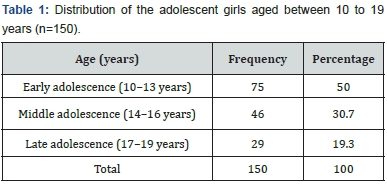
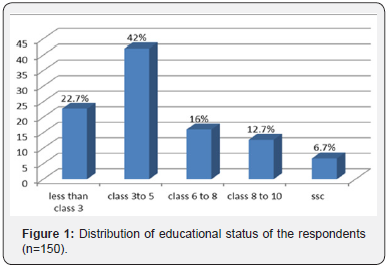
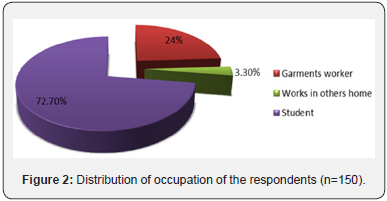
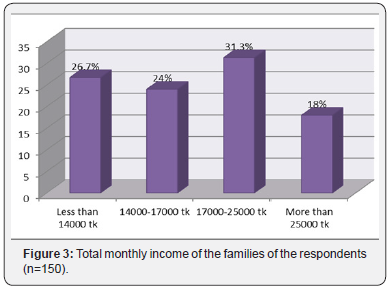
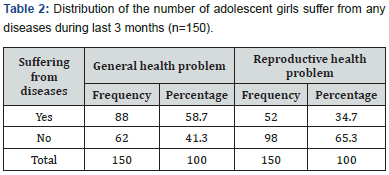

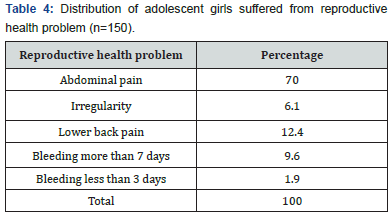
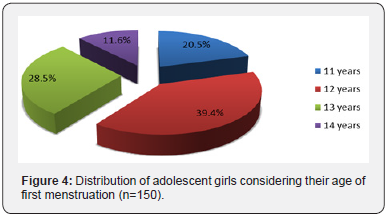

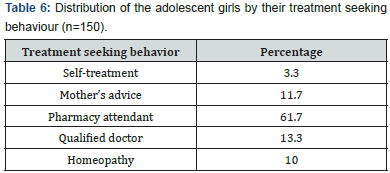
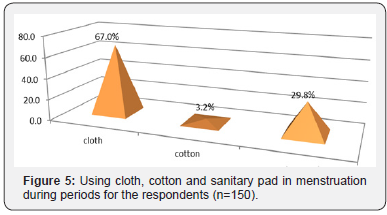
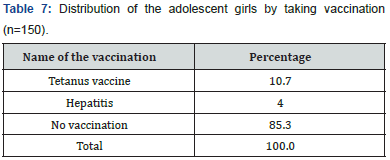
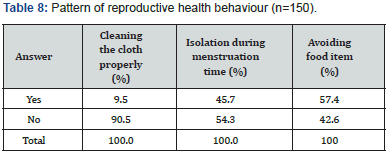
About 6.1% of the girls suffered from irregularity and 12.4% of the girls suffered from lower back pain (Table 4). Figure 4 shows that most of the girls (39.4%) encountered their period at the age of 12 years followed by 28.5% at the age of 13 years, 20.5% at 11 years and 28.5% at 14 years. It has been observed that 65.8% of the adolescent girls sought for treatment where 34.2% did not seek any treatment (Table 5). Table 6 describes that 61% of the adolescent girls received treatment from pharmacy attendant, only 13.3% of the adolescent girls received treatment from a qualified doctor and 10% of the girls received medicine from homeopath doctor. It has been observed that majority of the girls (85.3%) had not taken any vaccination. Only 10.7% had taken tetanus vaccine and 4% had taken hepatitis vaccine (Table 7). Figure 5 shows that, during periods, 67% of the respondents used cloth, 3.2 % used cotton and 29.8% used a sanitary pad. Table 8 indicates that among the adolescent girls those who used cloths during their menstruation, only 9.5% girls cleaned the cloth properly.45% of the girls isolated themselves during the menstruation. Again 57.4 % of the adolescent girls told that they avoid food items due to the foul smell, taboo, and anorexia during menstruation. There was a negative correlation between nutritional status and health issues of the adolescent girls (Table 9). There was a negative correlation between individual dietary diversity and health problem of the adolescent girls (Table 10).
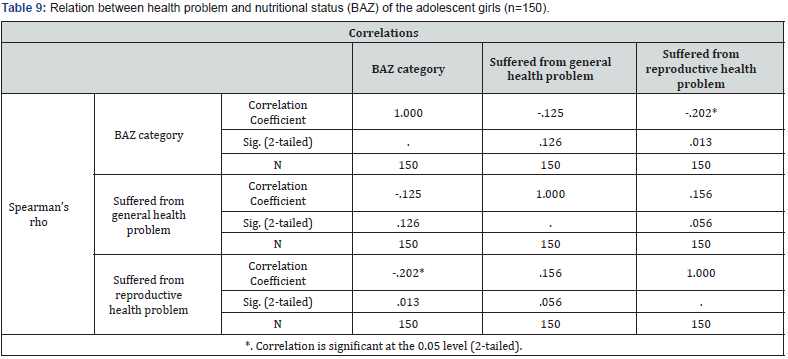
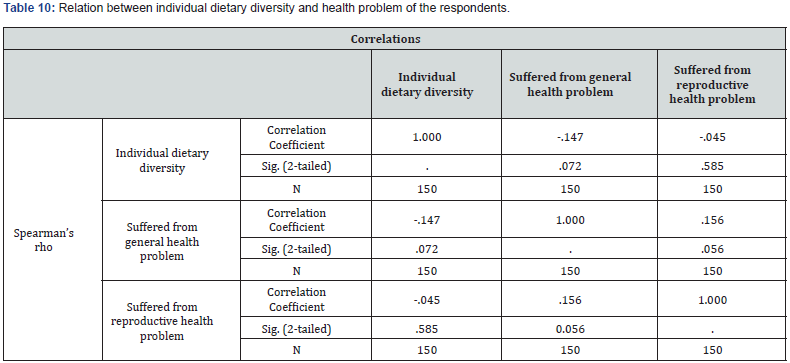
Discussion
In order to have a better-earning opportunity poor family from rural areas of our country migrate to cities and begin to live in slum areas. In a tiny period, these poor rural people become accustomed to living in such places and make temporary domicile there. As income earning opportunity is very limited in rural areas, growing number of rural people have migrated and settled temporarily in urban slums in recent years. The slum areas are mostly located by the side of roads and railways, in government khas (free) land and even on platforms erected on water bodies. Adolescence, a period of transition between childhood and adulthood, occupies a crucial position in the life of human beings. The poor nutritional status of adolescent girls has important implications in terms of physical work capacity and adverse reproductive outcomes [6]. Adolescents have specific health and development needs, and many face challenges that hinder their well-being. The findings of this study are kind of similar to some of the previous studies.
In this study, the majority of the girls (50%) were in age group 10-13 years (early adolescence), while 30.7% were in age group 14-16 years (middle adolescence) and 19.3% were in the age group 17-19 years (late adolescence). About 24% of the adolescent girls were garments worker. The educational status of the girls was quite satisfactory as the majority of the girls (72.7%) were students. 18% of the family had monthly income more than 25000 takas and 26.7% of the family had monthly income less than 14000 takas. Another study found that 51% of the household of the adolescent had monthly family income more than 20,000 takas and 11.4% had less than 10,000 takas [7]. Majority of the girls (58.7%) suffered from general health problem and 34% of them suffered from reproductive health problem during last three months. Most of the girls (49%) suffered from fever and 11% of the girls suffered from cough. Another study found that 17% of the adolescent girls suffered from fever and 8% of the girls suffered from caught [8].
This huge difference between the two studies probably because the corresponding study was done in the winter season. This study found about 70% of the respondents suffered from abdominal pain and 6.1% of the girls suffered from irregularity during menstruation. Another study found a similar percentage of irregular menstruation [8]. Average age of starting menstruation was found 12 years. This finding was almost similar to a different study where the mean age of starting menstruation was 13 [9]. This study found that almost 34.2% of the girls did not seek treatment for their health problems and those who sought for treatments are mainly dependent on pharmacy attendance (61.7%) for medicine. 67% of the girls used cloth during menstruation and 90.5% of the respondents said that they did not follow proper procedure to clean the cloth. About 85.3% of the adolescent girls did not take any vaccination. Half of the girls (54.3%) said that they isolated themselves and 57% of the girls said they avoid food items during their menstruation. As the adolescent girls in slum live in a very crowded area and they have very scarce financial supports and adequate knowledge, they face enormous trouble to lead a healthy life. Their health seeking behaviors are also affected by their poverty, knowledge, time allocation and availability of infrastructure.
In our country, the current healthcare systems scarcely address the health needs of adolescents. Furthermore, they are inadequately informed about the symptoms and consequences of reproductive health conditions. Another cross-sectional survey was conducted from November 2006 to March 2007 at two selected study areas (an Upazila of Sylhet division and a slum of Dhaka city) with 800 unmarried female adolescents aged 12-19 years. According to this study, approximately 50% of the sample reported experiencing menstrual problems in the last year. The predominant problems reported by participants included lower abdominal pain, back pain, irregular menstruation, and excessive bleeding during menstruation. Irrespective of the study area, only 40% of the female adolescents with menstrual problem sought treatment from qualified physicians [10]. Another study reveals that encouraging factors of health-seeking behaviors are: healthconscious (37%), beliefs in improved care (29%), better education (21%), knowledge of health and illness (8%).
A little payment as doctor’s fees influenced a large number of women (175 out of 357) to treat their illness in government hospitals. Other factors that encouraged them were family health consciousness (38%) followed by husband’s income (9%), husband’s knowledge of illness (7%), and affordable costs (2%). The study also found some discouraging factors of healthcare seeking behaviors these are: less information about essential services (55%), ignorance of illness (24%), personal dislikes to government hospitals (16%), shyness to disclose diseases complications (3%), and physical disability. The factors e.g. asymmetrical attitudes towards women (34%), lack of husband permission (33%), male doctors to female patients (22%), unemployment and dependency (15%) (Rahman et al, 2016) [11]. In our country, there is a very low facility for the treatment of the adolescent girls. Both Directorate General of Health Services and Directorate General of Family Planning implement reproductive health services through their programs on maternal, neonatal, and child health (MNCH), reproductive and sexual health, including family planning. Married women are the main beneficiaries of these services. In Bangladesh, however, unmarried female adolescents receive limited attention for healthcare issues by these existing programs (Ahmed et al, 2007) [12]. Some of the respondents hesitate to share their reproductive health problems.
Conclusion
This study concluded that one third of the girls suffered from reproductive health problem and majority of them sought pharmacy/ quack dependent treatment.

Comments
Post a Comment